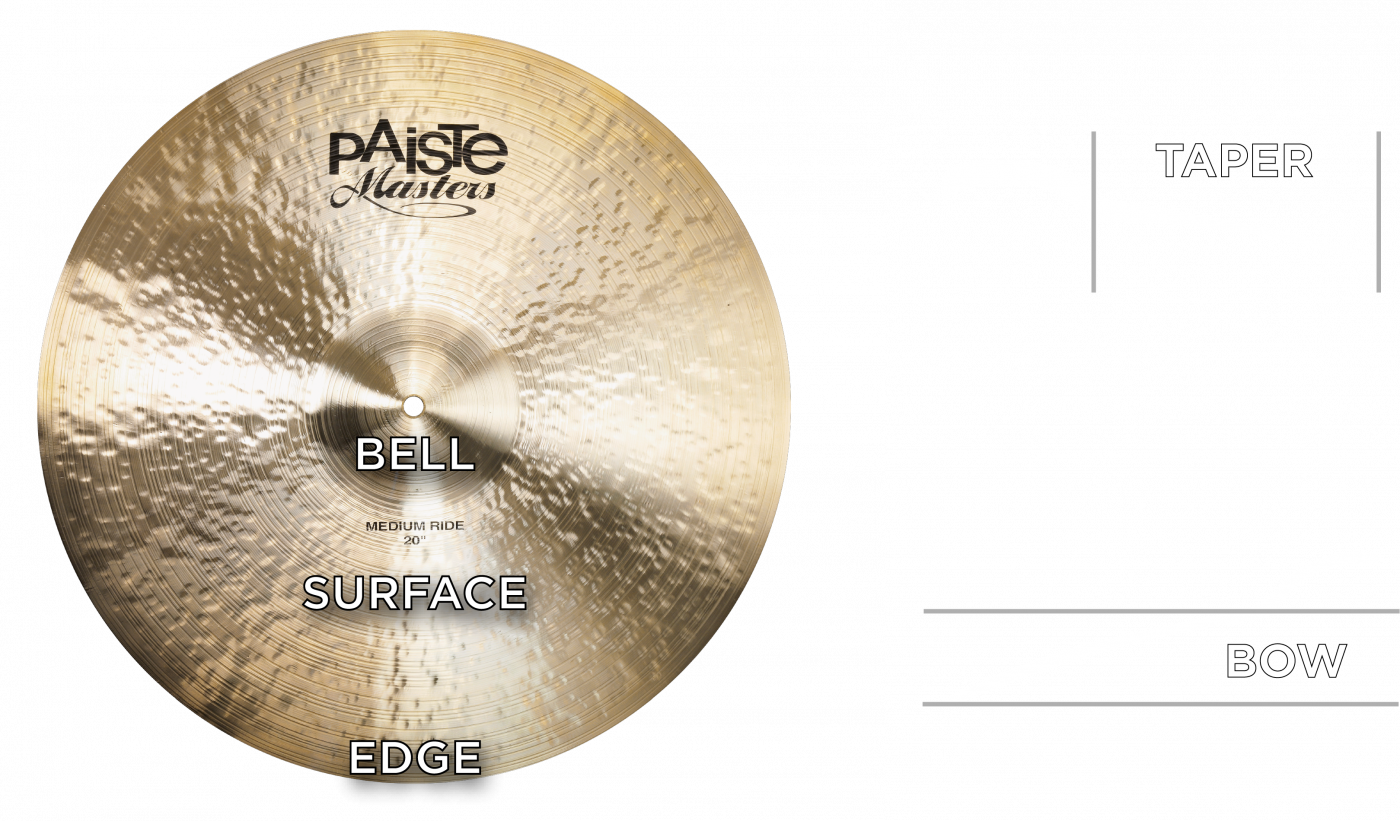Cymbal Anatomy
Whether you’re a new drummer or a seasoned professional, understanding the anatomy and function of your cymbals is key to unlocking your full creative potential. This section serves as a comprehensive guide to the different types of cymbals, their unique sounds, and how they can be used to shape your musical voice.
Cymbal Anatomy: The Foundation of Sound

Bell
The raised dome at the center of the cymbal. Striking the bell produces a bright, clear “ping” with a focused, high-pitched tone that cuts through any mix.
Bow
The main surface of the cymbal, extending from the bell to the edge. The bow is where most of the playing takes place, offering a wide range of sounds depending on where and how it is struck.
Edge
The outer rim of the cymbal. Striking the edge produces an explosive crash sound with a full, shimmering wash. The thickness and profile of the edge greatly influence the crash’s volume and decay.
Cymbal Types
Ride
The heartbeat of your groove. The ride is typically a larger, heavier cymbal played with the tip of the drumstick. It produces a clear “ping” sound with a defined stick articulation, while the wash of the bow adds a rich, sustained texture to your beat.
Crash
The accent and exclamation point of your playing. Crash cymbals are designed for powerful, explosive bursts of sound with a fast decay. They are used to punctuate phrases, signal transitions, and add dynamic emphasis to your music.
Hi-Hat
The rhythmic foundation of any drum kit. Consisting of two cymbals facing each other, they can be played closed for a tight “chick” sound, open for a loose “sloshy” wash, or with a stick for a crisp, articulate rhythm.
Splash
The quick, high-pitched details. Splashes are small, thin cymbals that produce a fast, bright splash of sound. Bells, often thicker and played on the dome, create a clear, high-volume “ping” that cuts through loud mixes.
China or Swishes
The exotic, trashy voices of the kit. Known for their distinct, aggressive “trash” sound with a fast attack and quick decay, these cymbals are perfect for adding unique sonic colors and unexpected accents.
Characteristics
Size
Measured in inches, a cymbal’s size is one of the most significant factors influencing its pitch, volume, and sustain.
Larger cymbals typically have a deeper pitch, a longer sustain, and more overall volume. A 22-inch ride cymbal, for example, will produce a fuller, more complex tone than a 20-inch one.
Smaller cymbals have a higher pitch, a quicker decay, and less volume. An 8-inch splash will sound fast and bright with an immediate cutoff, while a 10-inch will be slightly fuller.
Thickness
A cymbal’s thickness is crucial to its character, affecting everything from its tone to its dynamic range.
Thicker cymbals produce a brighter, higher-pitched sound with a longer sustain. They offer more stick definition and cut, but they have a narrower dynamic range and may require more force to open up.
Thinner cymbals create a darker, lower-pitched sound with a quicker decay. They have a wider dynamic range, responding with a full sound even to a light touch. Thinner cymbals also tend to produce more complex overtones, giving them a rich, musical character.
Weight
While closely related to thickness, weight is a broader characteristic that impacts a cymbal’s overall projection and feel.
Heavier cymbals have more power, higher volume, and a longer sustain. They are ideal for high-volume genres like rock and metal.
Lighter cymbals have a softer, darker sound and a broader dynamic range. They are perfect for nuanced playing in styles like jazz, blues, and acoustic music.
Bell Size
The bell is the raised dome at the center of the cymbal. Its size plays a critical role in the cymbal’s fundamental sound.
A larger bell produces a louder, more focused “ping” with a strong, cutting presence. It also contributes to the cymbal’s overall volume and sustain.
A smaller bell creates a softer, more concentrated “ping” that is easier to control. Its impact on the overall sound of the cymbal is more subtle.
Curvature or Bow
The curvature, or bow, refers to the degree of curve from the bell to the edge of the cymbal.
A higher curvature results in a brighter, higher-pitched sound with more sustain.
A flatter curvature produces a darker, lower-pitched sound with a quicker decay. This makes flatter cymbals ideal for vintage tones and situations where a fast, controlled sound is needed.
Drumstick Basics
Tip
The shape and material of the stick’s tip have a major impact on the sound you produce, especially on cymbals.
Acorn: A versatile, classic choice. The acorn shape produces a full, rich, and articulate tone. It provides a great balance of clarity and warmth, making it suitable for many genres.
Ball: This round tip offers a focused, bright, and clean sound. It’s excellent for intricate and articulate playing, especially on ride cymbals, where a clear “ping” is desired.
Barrel: With a larger surface area, the barrel tip creates a punchy, full-bodied, and loud sound. It’s a great choice for backbeats and for cutting through a dense mix in louder music styles.
Oval: The oval tip is known for its well-rounded, balanced tone. It provides a full, warm sound on drums and a consistent wash on cymbals, making it a reliable all-rounder.
Size
A drumstick’s length and thickness are key to shaping the sound and volume of your cymbals.
A heavier stick—one that is longer, thicker, or both—will generate more volume and a fuller, richer sound.
Conversely, a lighter stick—one that is shorter, thinner, or both—will produce less volume and a brighter, more articulate sound.
Stick Recommendations
The choice of drumstick is an extremely personal one. It should not only feel good in your hands but also produce the type of sound you prefer. We highly recommend experimenting with more than one stick type to unlock the maximum variety of sound from your cymbals.
When selecting a stick, a good rule of thumb is to match its weight to your cymbal’s size. Avoid using heavy sticks on smaller or thinner cymbals, as this can cause damage.
While there are alternatives to wood, we do not recommend them for use on cymbals. Only wood has the natural flexibility needed to produce a full, musical sound without putting excessive stress on your instruments. Most alternative materials are too rigid and can weaken or even break your cymbals. Metal sticks, for example, should be reserved exclusively for practice pads, not for your cymbals.
